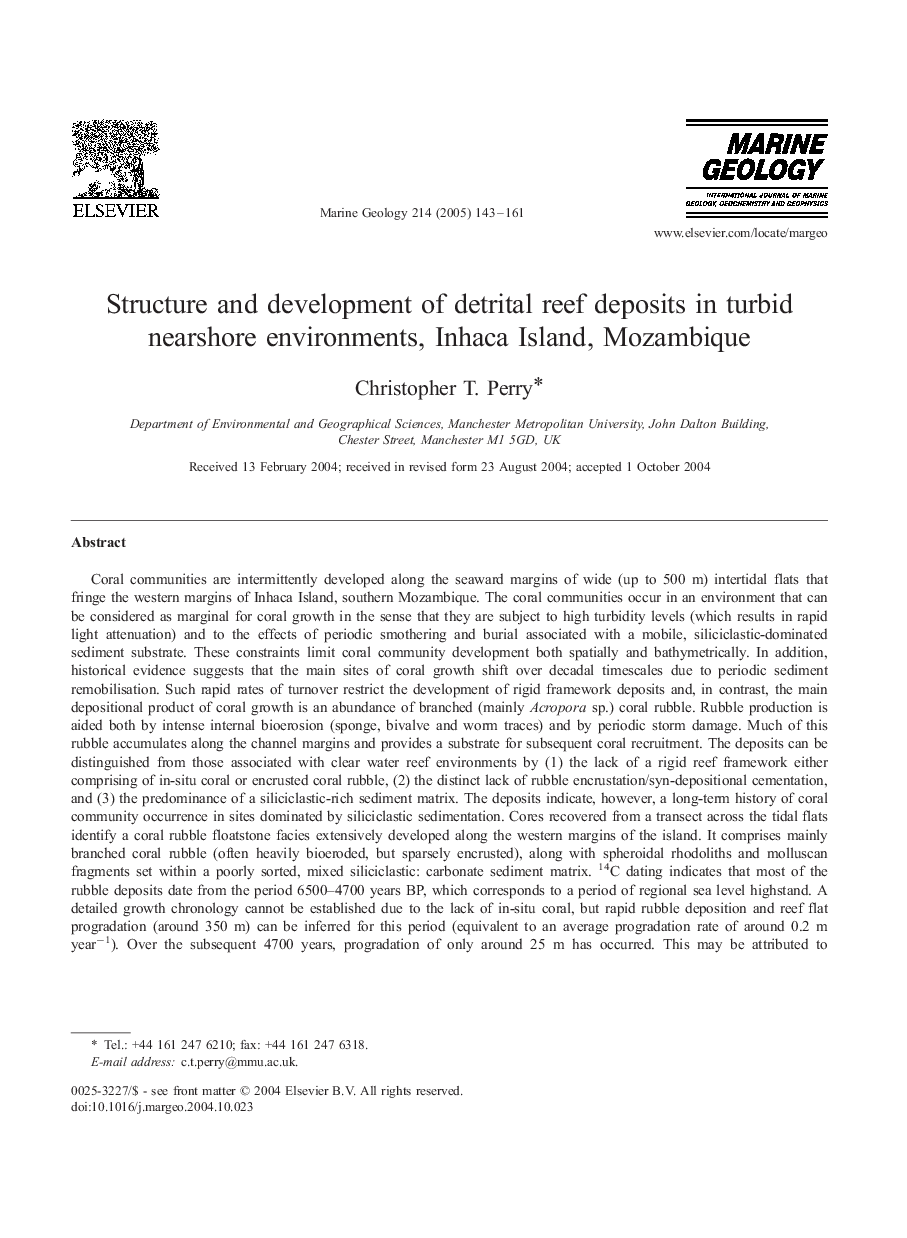| کد مقاله | کد نشریه | سال انتشار | مقاله انگلیسی | نسخه تمام متن |
|---|---|---|---|---|
| 9532807 | 1639230 | 2005 | 19 صفحه PDF | دانلود رایگان |
عنوان انگلیسی مقاله ISI
Structure and development of detrital reef deposits in turbid nearshore environments, Inhaca Island, Mozambique
دانلود مقاله + سفارش ترجمه
دانلود مقاله ISI انگلیسی
رایگان برای ایرانیان
موضوعات مرتبط
مهندسی و علوم پایه
علوم زمین و سیارات
ژئوشیمی و پترولوژی
پیش نمایش صفحه اول مقاله

چکیده انگلیسی
Coral communities are intermittently developed along the seaward margins of wide (up to 500 m) intertidal flats that fringe the western margins of Inhaca Island, southern Mozambique. The coral communities occur in an environment that can be considered as marginal for coral growth in the sense that they are subject to high turbidity levels (which results in rapid light attenuation) and to the effects of periodic smothering and burial associated with a mobile, siliciclastic-dominated sediment substrate. These constraints limit coral community development both spatially and bathymetrically. In addition, historical evidence suggests that the main sites of coral growth shift over decadal timescales due to periodic sediment remobilisation. Such rapid rates of turnover restrict the development of rigid framework deposits and, in contrast, the main depositional product of coral growth is an abundance of branched (mainly Acropora sp.) coral rubble. Rubble production is aided both by intense internal bioerosion (sponge, bivalve and worm traces) and by periodic storm damage. Much of this rubble accumulates along the channel margins and provides a substrate for subsequent coral recruitment. The deposits can be distinguished from those associated with clear water reef environments by (1) the lack of a rigid reef framework either comprising of in-situ coral or encrusted coral rubble, (2) the distinct lack of rubble encrustation/syn-depositional cementation, and (3) the predominance of a siliciclastic-rich sediment matrix. The deposits indicate, however, a long-term history of coral community occurrence in sites dominated by siliciclastic sedimentation. Cores recovered from a transect across the tidal flats identify a coral rubble floatstone facies extensively developed along the western margins of the island. It comprises mainly branched coral rubble (often heavily bioeroded, but sparsely encrusted), along with spheroidal rhodoliths and molluscan fragments set within a poorly sorted, mixed siliciclastic: carbonate sediment matrix. 14C dating indicates that most of the rubble deposits date from the period 6500-4700 years BP, which corresponds to a period of regional sea level highstand. A detailed growth chronology cannot be established due to the lack of in-situ coral, but rapid rubble deposition and reef flat progradation (around 350 m) can be inferred for this period (equivalent to an average progradation rate of around 0.2 m yearâ1). Over the subsequent 4700 years, progradation of only around 25 m has occurred. This may be attributed to reworking and erosion of the seaward margin of the deposits during periods of fluctuating sea level between 4700 and 900 years BP, or to a lack of seaward accommodation space.
ناشر
Database: Elsevier - ScienceDirect (ساینس دایرکت)
Journal: Marine Geology - Volume 214, Issues 1â3, 30 January 2005, Pages 143-161
Journal: Marine Geology - Volume 214, Issues 1â3, 30 January 2005, Pages 143-161
نویسندگان
Christopher T. Perry,